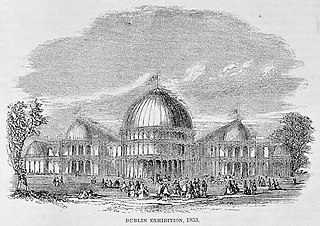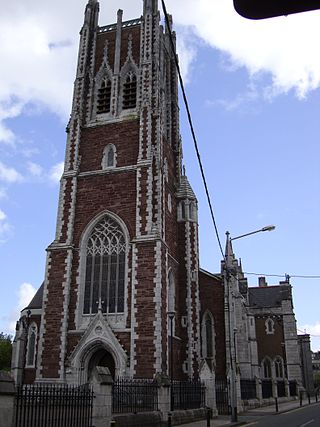
Expo '98 was an official specialised World's Fair held in Lisbon, Portugal from Friday, 22 May to Wednesday, 30 September 1998. The theme of the fair was "The Oceans, a Heritage for the Future", chosen in part to commemorate 500 years of Portuguese discoveries. The Expo received over 10 million visitors in 132 days, while 143 countries and many organizations were represented.

Cork Opera House is a theatre and opera house in Cork in Ireland. The first venue opened in 1855 on Emmet Place to the rear of the Crawford Art Gallery. This original building was destroyed by fire in 1955, and a replacement opened in 1965. With a number of additions in the early 21st century, the 1000-seat venue hosted over 100 theatre, music, opera, and comedy events in 2015.

The Exhibition of the Industry of All Nations was a World's Fair held in 1853 in what is now Bryant Park in New York City, in the wake of the highly successful 1851 Great Exhibition in London. It aimed to showcase the new industrial achievements of the world and also to demonstrate the nationalistic pride of a relatively young nation and all that she stood for. Jacob Aaron Westervelt, at that time Mayor of New York, was the President of the exhibition-committee. The general superintendent was Admiral Du Pont.

The Great Industrial Exhibition in 1853 was held in Dublin, Ireland. In its day, it was the largest international event to be held in Ireland. The Irish Industrial Exhibition Building, located on the grounds of Leinster House, housed the entire fair. It lasted from 12 May to 31 October, Queen Victoria accompanied by the Prince Consort and the Prince of Wales, paid an official visit on 29 August.
Events from the year 1852 in Ireland.

The Prima Esposizione Internazionale d'Arte Decorativa Moderna, held in Turin, Italy in 1902, was a world arts exhibition that was important in spreading the popularity of Art Nouveau design, especially to Italy. Its aim was explicitly modern: "Only original products that show a decisive tendency toward aesthetic renewal of form will be admitted. Neither mere imitations of past styles nor industrial products not inspired by an artistic sense will be accepted."

Thomas Kirk was an Irish sculptor.

The Brussels International Exposition of 1910 was a world's fair held in Brussels, Belgium, from 23 April to 1 November 1910. This was just thirteen years after Brussels' previous world's fair. It received 13 million visitors, covered 88 hectares and lost 100,000 Belgian francs.

The Irish International Exhibition was a world's fair held in Dublin in 1907, when all of Ireland was still part of the United Kingdom.

The Liège International Exposition was a world's fair held in Liège, Belgium, from 27 April to 6 November 1905 just 8 years after a Belgian exposition held in Brussels. Intended to show Liège's industrial importance, the fair also marked 75 years of Belgian Independence and 40 years of Leopold II's reign.

The Glasgow International Exhibition was the second of 4 international exhibitions held in Glasgow, Scotland during the late 19th and early 20th centuries. The exhibition took place during a period of half-mourning requested by Edward VII but was still popular and made more than £35000 profit. The exhibition was opened by the King's daughter, the Princess Louise, Duchess of Fife.

The 1888 Barcelona Universal Exposition was Spain's first International World's Fair and ran from 8 April to 9 December 1888. The second one in Barcelona was held in 1929.

The Antwerp International Exposition was a world's fair held in Antwerp, Belgium, between 2 May and 2 November 1885. It covered 54.3 acres (220,000 m2), attracted 3.5 million visits and broke even after spending 4 million Belgian francs There were 25 official participating nations including: Austria, Canada, France, Germany, Great Britain, the Ottoman Empire, Portugal, Serbia, Spain, Romania, the United States and some South American states. Australian wool growers sent exhibitions and won prizes.

The Gothenburg Tercentennial Jubilee Exposition was a world's fair held in Gothenburg, Sweden during 1923 marking 300th anniversary of the founding of the city. The fair opened 8 May and ran until 30 September.

Sir John Benson ICE was an Irish architect, born in Collooney, County Sligo. Although most of his work was in Cork, he was knighted for his design for the Dublin Great Industrial Exhibition.

The Auckland Exhibition, also known as the Auckland Industrial, Agricultural and Mining Exhibition, was held in Auckland Domain, Auckland, New Zealand, in 1913 and 1914.

The Exposition internationale du bicentenaire de Port-au-Prince was a world's fair held in Port-au-Prince, Haiti in 1949 to mark the 200th anniversary of the city's founding.

The International Exhibition of Arts and Manufactures was a world's fair held in Dublin, Ireland in 1865 attended by almost 1 million visitors.

The New Zealand Exhibition, which took place in Dunedin, New Zealand, in 1865, was a world's fair visited by approximately 31250 people. It was the first world's fair held in New Zealand. It opened on 12 January and ran until 6 May 1865.


















